April 1, 2021, tomorrow, Leica raises the prices on most of its digital cameras, including mine. This post offers earnest appreciation for making what I own more valuable. I don’t plan on selling anything, but […]


April 1, 2021, tomorrow, Leica raises the prices on most of its digital cameras, including mine. This post offers earnest appreciation for making what I own more valuable. I don’t plan on selling anything, but […]

On March 16, 2021, approaching the Vermont Street Bridge, I stopped for a single shot using Leica Q2 Monochrom. When wielding the camera, or my regular (e.g. color sensor) Q2, my habit is this: Stop, compose, capture one or two photos—single more likely, as is the case with the Featured Image. Vitals, aperture manually set: f/5.6, ISO 200, 1/400 sec, 28mm; 11:21 a.m. PDT.
When handling iPhone XS, I point and shoot, with little to no regard for composition—typically taking four to six shots, minimum. One reason: The display isn’t easy enough to see in the bright San Diego sunlight. Additionally, when there is motion, such as a frisky feline for my “Cats of University Heights” series, the smartphone proves more able, because of its smaller size but big screen for fast, on-the-fly composition.

Someone tell me where Joe Wallace lives, because I want to go there. Yesterday morning, I read his Wall Street Journal story, “Leap in Gas Prices Puts $3 a Gallon in Sight“, in state of disbelief. In sight, as in coming? Because here in San Diego, that reference means looking back. We passed three bucks a gallon well more than a month ago. In fact, before President Executive Order killed off the Keystone Pipeline, the price had been $2.86 for months—and that was up 30 cents from Summer 2020—at my local economy filling station.
“Gasoline prices at pumps in the U.S. hit an average of $2.88 a gallon over the past week, according to the AAA”, Joe writes. “In California, the most expensive market, average prices stand at $3.88, according to AAA”. Hours later, I shot the Featured Image, with Leica Q2 Monochrom, specifically to illustrate this essay. Granted, Chevron charges more than many competitors but not outrageously greater than the $3.88 at nearby Valero.
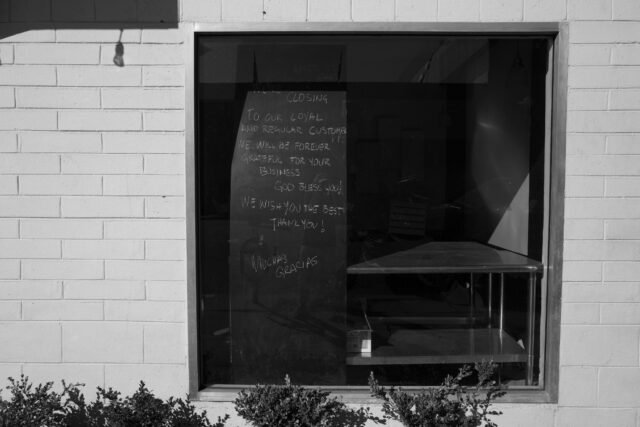
One year ago today, California bars, breweries, and eateries stopped serving customers indoors, shifting to delivery and take-out services only—as ordered by Governor Gavin Newsom. On March 19, 2020, he issued a “stay-at-home” order for all Californians that went into effect the next day. Restrictions would later lift only to be reimposed—nearly as harsh during the Thanksgiving and Christmas holidays as the pandemic‘s early-declaration days.
Today, after months of onerous prohibitions upon local businesses, San Diego County rose from the most restrictive tier, which permits malls and retailers to operate at 50-percent capacity; aquariums, churches, movie theaters, museums, restaurants, and zoos to allow customers indoors at 25-percent capacity; and gyms and hotels to operate at 10-percent capacity. Oh joy. Beat me with the stick, because it feels so good compared to the baseball bat you were whacking with.
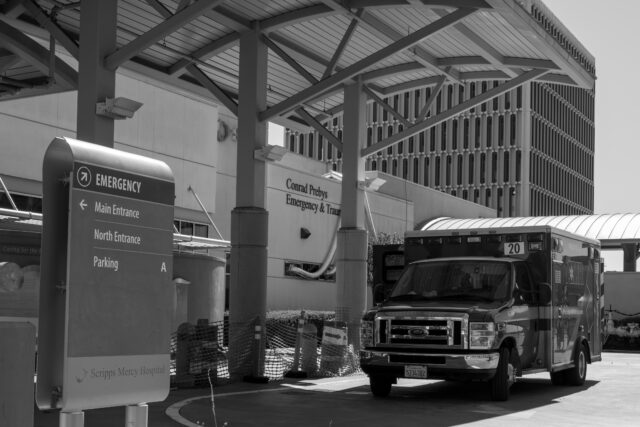
The four words of this essay’s title are exactly my reaction to learning about China’s massive quarantine for the Novel Coronavirus in late-January 2020. I warned my wife and anyone else to prepare for the spread of fear: How it would infect and disrupt distribution of goods and services; how panic would lead to supply shortages; how desperation might cause people to react violently. But following the World Health Organization declaring a pandemic, one year ago today, the outcome over 12 months is much worse than I expected.
Society didn’t suddenly break down from widespread contagion, like portrayed by Hollywood films and TV shows. Instead, the economic and social fabrics shredded over longer time, as well-meaning citizens obeyed orders to “shelter-in-place“, “social distance“, and close their businesses. My contention: When Science catches up with collated data, the forensic analysis will show that governments over-reacted with lockdowns that inflicted more harm than the virus that everyone feared. Meaning: The cure is far more damaging than the disease, which danger is overblown.

On March 1, 2021, as I walked along University Ave. in San Diego’s Hillcrest neighborhood, a huge banner beckoned my attention. I frequently see signs like this in apartment and house windows but nothing this large nor with Still added. I used iPhone XS to snap the companion to the Featured Image, which I captured the next day with Leica Q2 Monochrom. Vitals for the smartphone shot, which is composed as taken: f/2.4, ISO 16, 1/761 sec, 52mm (film equivalent); 9:05 a.m. PST. For the camera, aperture manually set: f/8, ISO 200, 1/400 sec, 28mm; 10:27 a.m.
Why is such a banner, with Still added, seen as necessary? The trial of former police officer Derek Chauvin is underway in Minneapolis. He is implicated in the death of George Floyd, whose alleged homicide sparked racial riots and protests in the city and across the country—with loud voices crying “defund the police” and “no justice, no peace”. Nearly ten months later, Americans have largely stopped rallying for racial reckoning—and the organization that gathered them before isn’t yet, if it ever will, marshaling masses together. Black lives still matter, but the movement apparently does not.
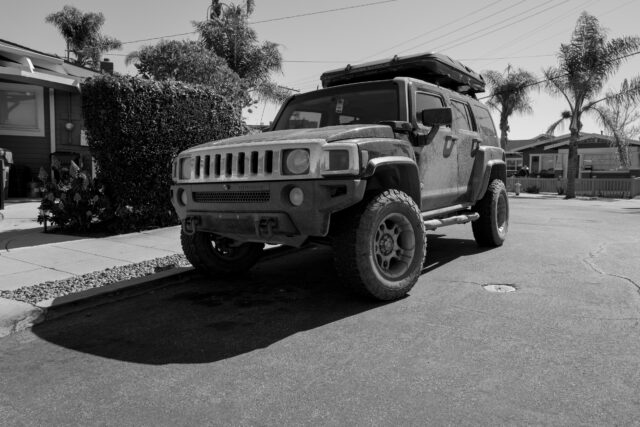
San Diego changes around me, particularly from the cost-of-living increases brought by the ever-growing emigration of high-tech workers escaping Northern California; they’re well-paid and find here comparatively affordable rents and home prices—all of which rise as more Googler-types relocate. SARS-CoV-2 (severe acute respiratory syndrome Coronavirus 2)/COVID-19 lockdowns set them free to work from anywhere there is reliable Internet.
So I was only modestly surprised to see a Hummer parked off of Lincoln in the University Heights neighborhood on Feb. 21, 2021. What amazed me more, when arriving here in October 2007, was the number of Hummers seen seemingly everywhere. You could have played an adapted Punch Buggy—and lost—for the few non-military Hummers traveling about the Washington, D.C. metro area that we left nearly 14 years ago. In San Diego, the contrast was stark, and I wondered why all the gas guzzlers given stereotypes about carbon-aware, environmentally-focused California culture. Should I answer status symbol? The late-2008 economic collapse purged the oversize vehicles from local roadways. Who could afford higher monthly payments or gasoline for a roadster rated city driving of 13 miles to-the-gallon? By mid-2009, their numbers had diminished to near nothing; that I observed. Eventually, as the economy recovered, based on increasing sightings, various Jeep models replaced the Hummers as all-around utility vehicles.

The saga starts simply: On Feb. 17, 2021, Annie suffered tummy upset all day, along with loss of energy. By late afternoon, my wife had developed a fever of 37.8 degrees Celsius (100.1 Fahrenheit). Morning of the 18th, her body temperature had fallen to 37.2 C (99 F) before returning to normal and staying that way. But she felt crummy and lethargic. More worrisome: Low-grade fever is one of the signature symptoms of COVID-19—the disease caused by SARS-CoV-2 (severe acute respiratory syndrome Coronavirus 2).
Next day, the 19th, I felt off and started coughing; often. If not for Annie’s fever the story would end there, but the symptom shouldn’t be ignored. I checked our health insurer’s website, which indicated that COVID-19 testing would be free with a referral. Around 8 a.m., when the doctor’s office opened, I cancelled a 9 a.m. self-defense lesson with my trainer and called our physician, with whom the scheduler set up an 11 a.m. phone appointment. Who would guess problems would start there.
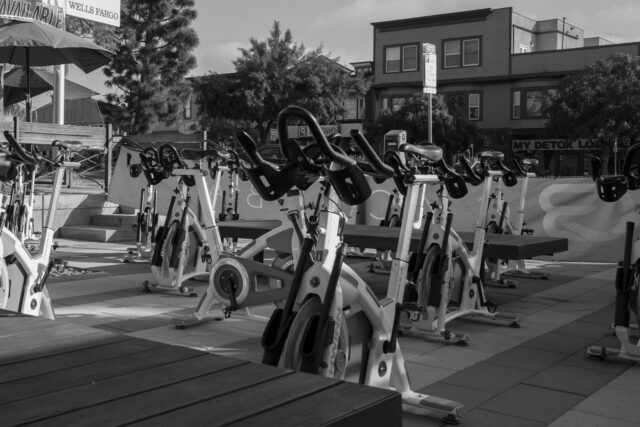
This afternoon, I walked home through the San Diego neighborhood of Hillcrest, where waits one of the many artifacts of the SARS-CoV-2 (severe acute respiratory syndrome Coronavirus 2)/COVID-19 lockdowns. Schwinn stationary bikes are available for those locals looking to exercise outdoors, which is a periodic requirement depending on which way the stay-at-home order blows; sometimes indoor gyms are allowed to open, oftentimes not.
I have seen souls pedaling together during tandem instruction. But nobody rode the road to nowhere when I happened to pass by. Unfortunately, I carried along Leica Q2 Monochrom, which was supposed to effuse magnificent ambience in my nibble hands. But the scene was overly cluttered; in black and white the compositions are too busy, with little comfortable place for the eyes to naturally go.
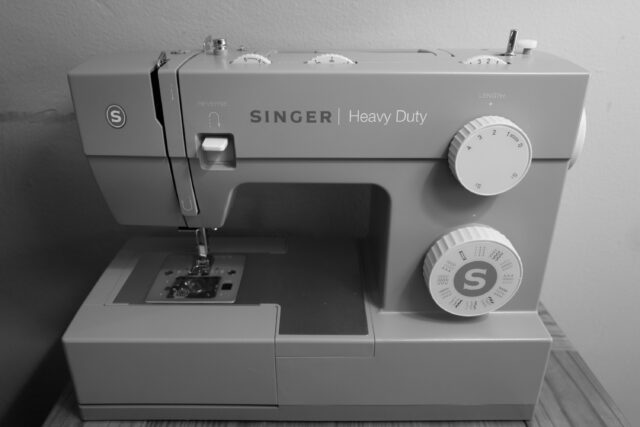
In early September 2014, I bought my wife the Singer Heavy Duty 4432 Sewing Machine from Amazon for $99.99. Annie had hoped to make some of her own clothes—something she had long aspired to do. Perhaps if we lived in a larger apartment, she would have achieved her dream; setting up and using the Singer—portable as the thing is—required more space than we could spare.
Fast-forward to late-December 2020. Annie saw a post on Nextdoor from someone looking to buy a sewing machine. Budget: $100. Seeing as the 4432 had never been used, other than to make sure it operated, Amazon’s current price was $209.99, and the manufacturer’s $289.99, $100 would be a deal. Annie responded, and the woman, who we’ll call Grace, agreed to buy the Singer, which would come with extra sewing doodads.

At Noon EST today, Joseph R. Biden Jr. ascended to the Presidency of the United States, having taken the oath of office about 12 minutes earlier. He later issued 15 executive orders, which is an unprecedented number compared to his predecessors. None to one is typical on the first day. Democrats are unified controlling the Executive and Legislative branches of government.
Biden’s first-day actions and posturing by the House and Senate are indicative of a party with a mandate. But there is none. The 46th President won the 2020 Election by slimmer-than-appears electoral margin and Democrats command a narrow number of seats in Congress. The data, along with recent protesting and rioting by conservative and liberal constituents, reflect a nation deeply divided, rather than united behind the new Commander-in-Chief. The situation portends that his calls for unity will fail, although I hope otherwise.
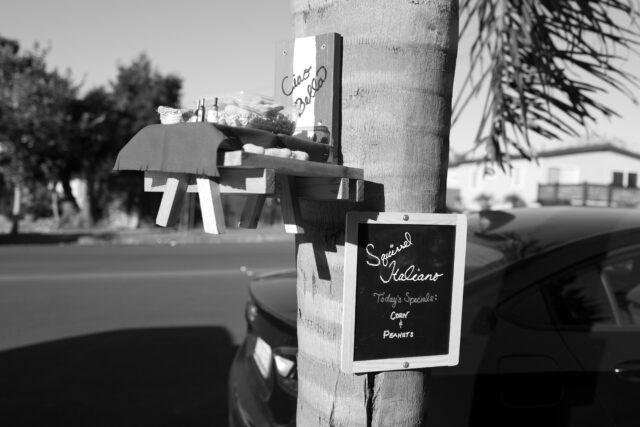
The mom of Bruce, Guido, and Little—all of which appeared in my “Cats of University Heights” series—put out a clever, cutesy squirrel feeder. There is a sad sweetness to the gesture. She can’t serve people—no thanks to California Governor Gavin “Gruesome” Newsom’s order prohibiting all restaurant dining—and last I heard her employer might join the increasing list of local eateries and pubs put out of business.
In this County, SanDiegoVille keeps a running list of the permanently shuttered since the pandemic’s start. I count 115 eating or drinking establishments, but more when accounting for businesses with multiple locations.. Uncontrollable spread of COVID-19, which is caused by SARS-CoV-2 (severe acute respiratory syndrome Coronavirus 2), demonstrates that forced closures are ineffective subduing the pandemic.